- Home
- Garden Wildlife
- Insects
- Hemiptera
- Aphids
Aphids
Aphids are sap-sucking insects in the Aphidoidea superfamily of the order Hemiptera. They are also commonly known as greenfly and blackfly, although those are not the only colours that aphids come in. Some, like the beech aphid, Phyllaphis fagi, and woolly aphid on apple, Eriosoma lanigerum, are usually covered in a white waxy fluff that they secrete from their bodies (as with adelgids living on conifers). Most aphids are 2-3mm in length but some are up to 5-6mm. Both winged and wingless adult forms occur at certain times of year.
Species in Britain and Ireland
There are more than 500 species of aphid recorded in Britain and Ireland. Some are mainly found in glasshouses or on house plants. Jennifer Owen recorded only 5 species, but they were not a prime study group for her.
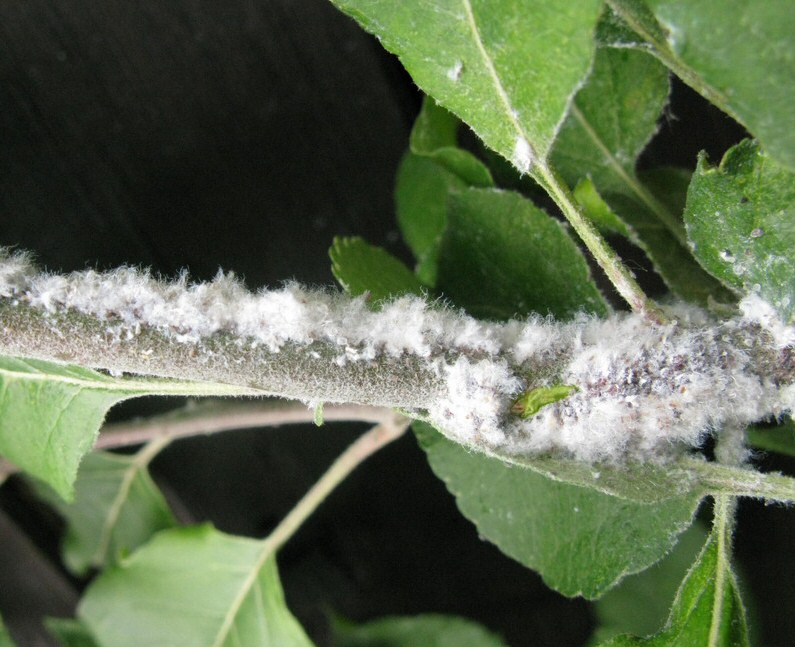
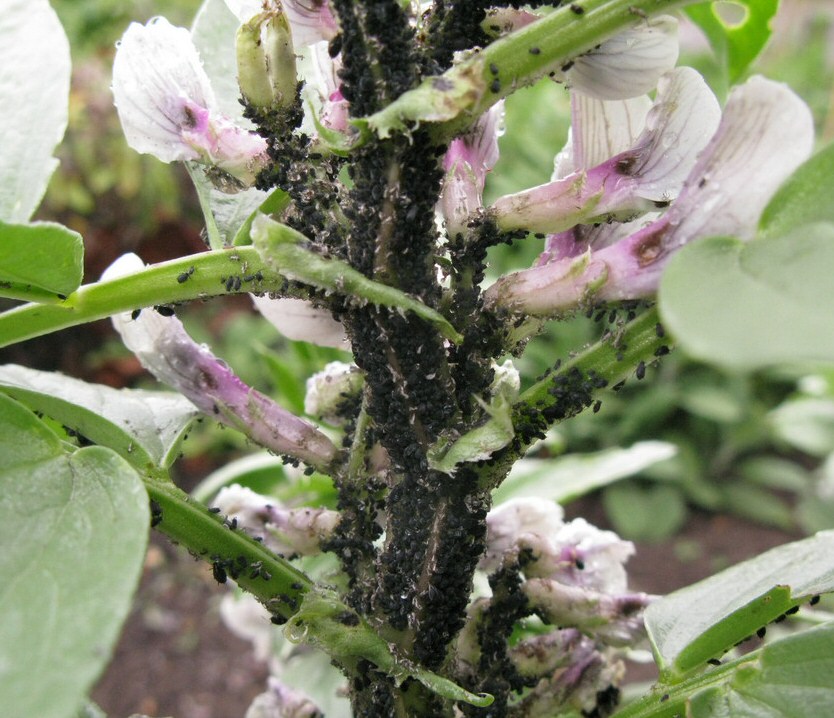
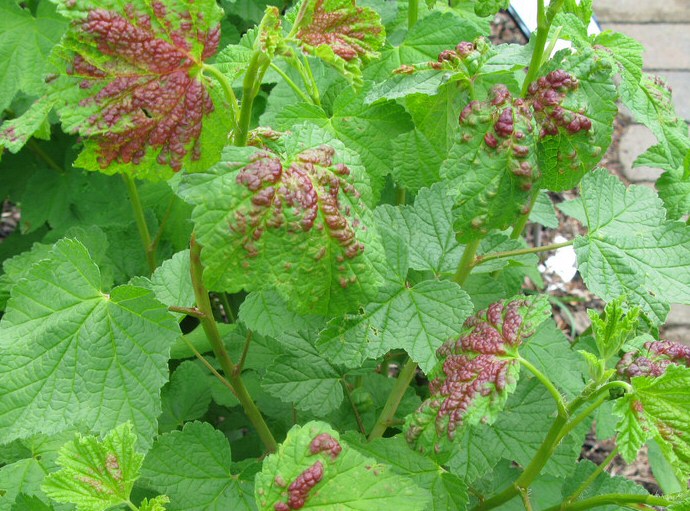
Woolly aphid Eriosoma lanigerum on apple Cabbage aphid Brevicoryne brassicae
nymphs,winged and wingless adults
Biology
Most aphids suck sap from shoot tips, plant stems, foliage and flower buds but some specialise in feeding from roots. While feeding, some aphids secrete chemicals into the plant that cause leaf curling and/or stunted growth. They imbibe a sugar-rich sap, not all of which can be digested, so it is a sticky sugary excrement that comes out of the rear end of aphids. This is known as honeydew and it accumulates on the upper surface of the foliage and the ground underneath infested plants. Some species of ants "farm" aphids for their honeydew, ‘milking’ them by stroking the aphids’ abdomens with their antennae to encourage them to release droplets of honeydew. The ants defend their livestock against predators. Other insects will feed on the surface film of honeydew on leaves, including on some occasions honeybees. Some ants, such as the yellow ant Lasius flavus manage "herds" of aphids on plant roots in their colony.
.jpg)
_on_a_rose_bud.jpg)
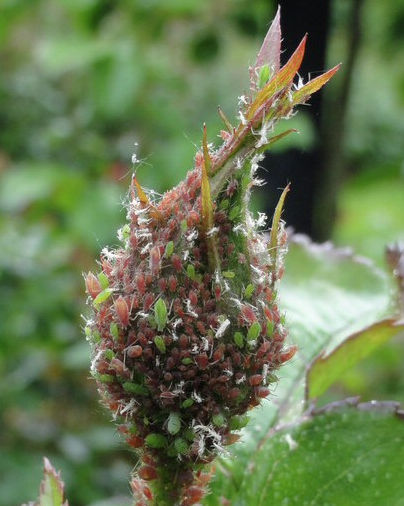
Black bean aphid Aphis fabae Rose aphid Macrosiphum rosae Rose aphid - winged or alate form
Note that the one in centre right
is exuding a drop of honeydew
bewerkt.jpg)
Some aphids have relatively simple life cycles, spending the whole year on a single type of plant. An example is the mealy cabbage aphid, Brevicoryne brassicae, which stays on various brassicas throughout the year. It overwinters as eggs on brassica stems and for most of the spring-autumn it is present as wingless aphids. In early summer and early autumn, winged forms develop that will fly away to infest other brassicas. Woolly aphid on apple can also occur on Pyracantha and Cotoneaster horizontalis but it stays with these plants throughout the year. This species overwinters as nymphs, rather than eggs.
Many aphids, have more complex life cycles that require different types of host plant depending on the time of year. Typically, these aphids spend the winter months as eggs on particular woody plants. The eggs hatch as the winter host plants come into growth and the new foliage is developing. Several generations occur on the foliage of the winter host plant during the spring. These aphids are all-female wingless forms that give birth to aphid nymphs without an egg stage. In late spring-early summer, a generation of winged females develops and they fly to the summer host, which is usually a non-woody plant. During the summer, several generations of wingless all-female aphids producing live young develop on the summer host. In late summer-early autumn, a generation of winged males and females develop that fly away to suitable winter host plants. On arrival, they will mate and the females lay overwintering eggs.
Examples of garden aphids with two-plant life cycles include:
- Black bean aphid, Aphis fabae. Winter-spring on Euonymus, Viburnum and Philadelpus; summer on broad, french and runner beans, nasturtium, dahlia and poppy
- Currant blister aphid, Cryptomyzus ribis. Winter-spring on red and black currant; summer on a wild flower, hedge woundwort
- Plum leaf-curling aphid, Brachycaudus helichrysi. Winter-spring on wild and cultivated plums; summer on various herbaceous plants
- Lettuce root aphid, Pemphigus bursarius. Winter-spring on poplar; summer on lettuce roots
Role of aphids in gardens
It is likely that at some plants in every garden will have a population of aphids. Many insects, including ladybirds, hoverfly larvae, lacewings and parasitic wasps, prey on aphids, as will many birds.
Most garden plants are susceptible to at least one species of aphid. Some species can cause serious damage to fruits, vegetables and ornamental plants. Aphids can also spread plant virus diseases on their mouthparts or in the fluids they secrete when they move to new plants.
Examples of aphid damage:
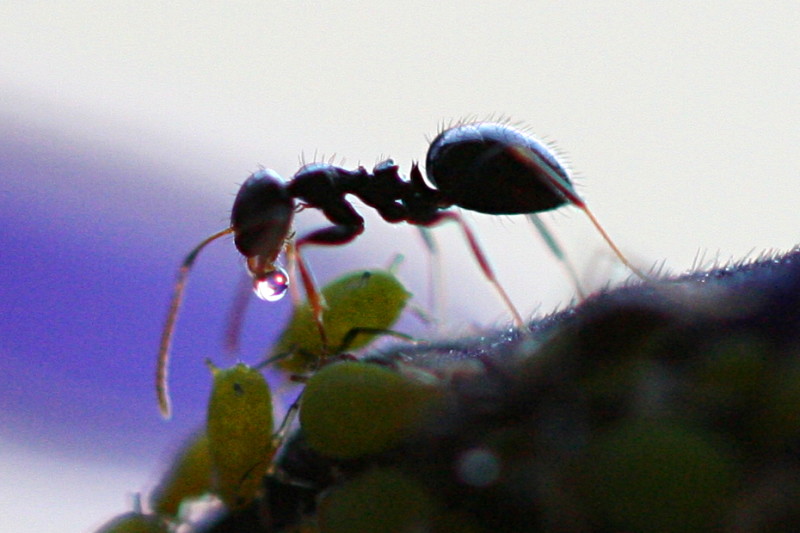
Ant consuming a drop of honeydew from an aphid
Black sooty moulds often develop on the honeydew. As with other insects, aphids shed their outer skin on several occasions as the nymphs develop. Regardless of the colour of the aphid, these cast skins are white and are readily seen on the foliage, especially where there is a coating of sooty mould.
Reproduction and life cycle
Aphid lifecycles vary, but in many species most of the spring and summer populations consist of wingless forms that are all females. They do not need to mate to reproduce and they do not lay eggs, instead are viviparous,giving live birth to nymphs. Winged forms develop when aphid colonies become overcrowded or the feeding quality of the host plant declines, requiring the aphids to move elsewhere. Males generally only occur in late summer-autumn when aphids need to produce eggs that will overwinter, and are genetically identical to their sisters, but lack one "X" sex-chromosome.
![Aphid giving birth Photo: MedievalRich [CC BY-SA 3.0 (http://creativecommons.org/licenses/by-sa/3.0/)]](images/Aphid-giving-birth.jpg)
"Greenfly" aphid giving live birth to a nymph.
Left: Currant blister aphid Cryptomyzus ribis Right: Black bean aphid Aphis fabae on broad bean
Other sources of information
Website
Website of the Rothamsted Insect Survey
An identification guide for aphids on cultivated plants
RHS information on aphids
RHS information on aphid predators
Books
Blackman, R. L. (2010) Handbooks for the Identification of British Insects. Aphids – Aphidinae (Macrosiphini). Royal Entomological Society
Dixon, T. & Thieme, T. (2007) Naturalists' Handbooks 29 Aphids on deciduous trees. Richmond Publishing
Stroyan, H. L. G. (1977) Handbooks for the Identification of British Insects Vol 2 part 4a. Homoptera - Aphidoidea Chaitophoridae and Callaphididae – out of print but available as a free download here.
Page drafted by Andrew Halstead, reviewed by Andrew Salisbury, edited by Steve Head
Aphids
Aphids are sap-sucking insects in the Aphidoidea superfamily of the order Hemiptera. They are also commonly known as greenfly and blackfly, although those are not the only colours that aphids come in. Some, like the beech aphid, Phyllaphis fagi, and woolly aphid on apple, Eriosoma lanigerum, are usually covered in a white waxy fluff that they secrete from their bodies (as with adelgids living on conifers). Most aphids are 2-3mm in length but some are up to 5-6mm. Both winged and wingless adult forms occur at certain times of year.
Species in Britain and Ireland
There are more than 500 species of aphid recorded in Britain and Ireland. Some are mainly found in glasshouses or on house plants. Jennifer Owen recorded only 5 species, but they were not a prime study group for her.
.jpg)

_on_a_rose_bud.jpg)
Black bean aphid Aphis fabae Rose aphid Macrosiphum rosae Note that the one in centre right
is exuding a drop of honeydew
Rose aphid Macrosiphum rosae
in the winged or alate form.
Woolly aphid Eriosoma lanigerum on apple Cabbage aphid Brevicoryne brassicae
nymphs,winged and wingless adults
Biology
Most aphids suck sap from shoot tips, plant stems, foliage and flower buds but some specialise in feeding from roots. While feeding, some aphids secrete chemicals into the plant that cause leaf curling and/or stunted growth. They imbibe a sugar-rich sap, not all of which can be digested, so it is a sticky sugary excrement that comes out of the rear end of aphids. This is known as honeydew and it accumulates on the upper surface of the foliage and the ground underneath infested plants. Some species of ants "farm" aphids for their honeydew, ‘milking’ them by stroking the aphids’ abdomens with their antennae to encourage them to release droplets of honeydew. The ants defend their livestock against predators. Other insects will feed on the surface film of honeydew on leaves, including on some occasions honeybees. Some ants, such as the yellow ant Lasius flavus manage "herds" of aphids on plant roots in their colony.
bewerkt.jpg)

Ant consuming a drop of honeydew from an aphid

Black sooty moulds often develop on the honeydew. As with other insects, aphids shed their outer skin on several occasions as the nymphs develop. Regardless of the colour of the aphid, these cast skins are white and are readily seen on the foliage, especially where there is a coating of sooty mould.
Reproduction and life cycle
Aphid lifecycles vary, but in many species most of the spring and summer populations consist of wingless forms that are all females. They do not need to mate to reproduce and they do not lay eggs, instead are viviparous,giving live birth to nymphs. Winged forms develop when aphid colonies become overcrowded or the feeding quality of the host plant declines, requiring the aphids to move elsewhere. Males generally only occur in late summer-autumn when aphids need to produce eggs that will overwinter, and are genetically identical to their sisters, but lack one "X" sex-chromosome.
![Aphid giving birth Photo: MedievalRich [CC BY-SA 3.0 (http://creativecommons.org/licenses/by-sa/3.0/)]](images/Aphid-giving-birth.jpg)
"Greenfly" aphid giving live birth to a nymph.
Some aphids have relatively simple life cycles, spending the whole year on a single type of plant. An example is the mealy cabbage aphid, Brevicoryne brassicae, which stays on various brassicas throughout the year. It overwinters as eggs on brassica stems and for most of the spring-autumn it is present as wingless aphids. In early summer and early autumn, winged forms develop that will fly away to infest other brassicas. Woolly aphid on apple can also occur on Pyracantha and Cotoneaster horizontalis but it stays with these plants throughout the year. This species overwinters as nymphs, rather than eggs.
Many aphids, have more complex life cycles that require different types of host plant depending on the time of year. Typically, these aphids spend the winter months as eggs on particular woody plants. The eggs hatch as the winter host plants come into growth and the new foliage is developing. Several generations occur on the foliage of the winter host plant during the spring. These aphids are all-female wingless forms that give birth to aphid nymphs without an egg stage. In late spring-early summer, a generation of winged females develops and they fly to the summer host, which is usually a non-woody plant. During the summer, several generations of wingless all-female aphids producing live young develop on the summer host. In late summer-early autumn, a generation of winged males and females develop that fly away to suitable winter host plants. On arrival, they will mate and the females lay overwintering eggs.
Examples of garden aphids with two-plant life cycles include:
- Black bean aphid, Aphis fabae. Winter-spring on Euonymus, Viburnum and Philadelpus; summer on broad, french and runner beans, nasturtium, dahlia and poppy
- Currant blister aphid, Cryptomyzus ribis. Winter-spring on red and black currant; summer on a wild flower, hedge woundwort
- Plum leaf-curling aphid, Brachycaudus helichrysi. Winter-spring on wild and cultivated plums; summer on various herbaceous plants
- Lettuce root aphid, Pemphigus bursarius. Winter-spring on poplar; summer on lettuce roots
Role of aphids in gardens
It is likely that at some plants in every garden will have a population of aphids. Many insects, including ladybirds, hoverfly larvae, lacewings and parasitic wasps, prey on aphids, as will many birds.
Most garden plants are susceptible to at least one species of aphid. Some species can cause serious damage to fruits, vegetables and ornamental plants. Aphids can also spread plant virus diseases on their mouthparts or in the fluids they secrete when they move to new plants.
Examples of aphid damage:
Currant blister aphid Cryptomyzus ribis Black bean aphid Aphis fabae on broad bean
Other sources of information
Website
Website of the Rothamsted Insect Survey
Books
Blackman, R. L. (2010) Handbooks for the Identification of British Insects. Aphids – Aphidinae (Macrosiphini). Royal Entomological Society
Dixon, T. & Thieme, T. (2007) Naturalists' Handbooks 29 Aphids on deciduous trees. Richmond Publishing
Stroyan, H. L. G. (1977) Handbooks for the Identification of British Insects Vol 2 part 4a. Homoptera - Aphidoidea Chaitophoridae and Callaphididae – out of print but available as a free download here.
Page drafted by Andrew Halstead, reviewed by Andrew Salisbury, edited by Steve Head














